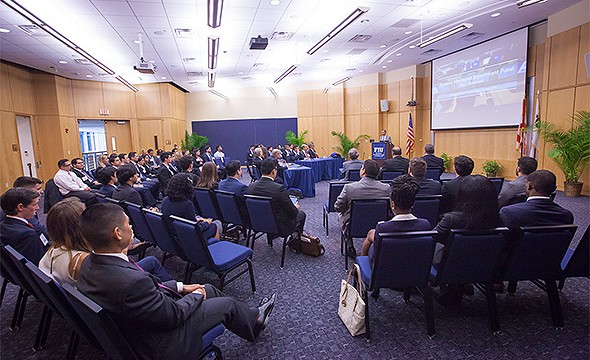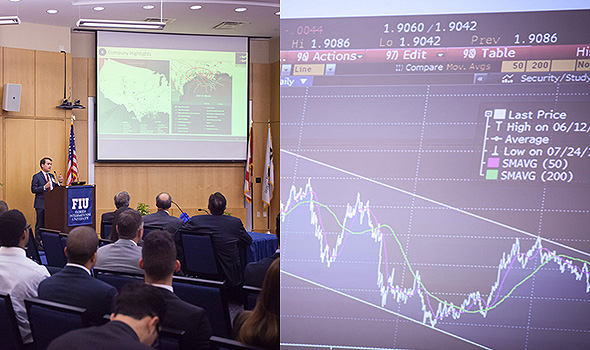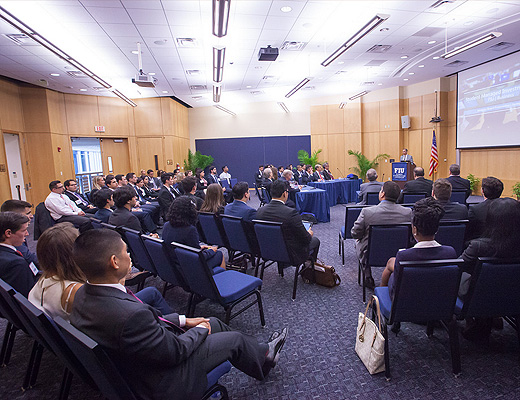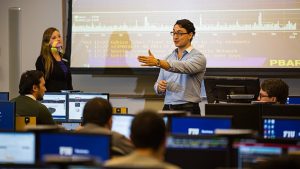
Twice a year, students enrolled in FIU College of Business’ Student Managed Investment Fund (SMIF) course seek out potentially profitable companies for inclusion in the university’s $300,000 student-run portfolio.
The dollars are real, and the stakes are high. Teams of students must choose a single company within each of eight sectors – consumer staples, consumer discretionary, energy, financials, healthcare, industrials, materials, and technology. Then, they prepare and present a full investment analysis, including financial statements, equity forecasts, plans for new products, and comparables with competitors.
The spring 2015 teams presented their picks to the advisory board, comprised of College of Business faculty and financial professionals, at the April 30 end-of-semester event. This year’s recommendations impressed the panel. Of the eight companies recommended for investment, six were approved by the board.
“I felt I was at an analysts meeting,” fund board member Jorge Miranda, founder and chief technology officer of Desoto Energy, said of the presentations. “They were playing the role in real life and making recommendations for clients.”

SMIF investments in the approved companies will be made this week.
“We take a macro view of an undervalued company to understand what issues they face and how they positively or negatively affect our investments,” said Anya Schmidt, a double major in finance and international business, who worked as an information technology sector analyst. “The ultimate goal is to diversify and increase the value of the portfolio.”
A veteran software developer, Miranda was especially impressed with the quality and depth of the analysis done by the SMIF students. “This is what I’d expect them to produce in their future jobs.”
In-depth analysis zeroes in on potential investments.
One of the presentations that captured the advisory board’s attention was in the healthcare sector. The team analyzed Lannett Company, Inc., maker of generic medications. The company posted net sales of $151 million for fiscal year 2013 and $193 million for the first three quarters of fiscal year 2014. Lannett is in growth mode with new drugs pending FDA approval and the upcoming acquisition of privately held Silarx Pharmaceuticals.
The analysis, Miranda admitted, inspired him to look more closely at the drug-maker. “I don’t know Lannett, but after seeing the presentation it’s something I would consider as an investment.”
Undervalued and poised for success.
Schmidt and her team took an in-depth look at Micron, manufacturer of digital memory technologies and products with operations in the U.S. and China. The largest share of the company’s revenue comes from China, Schmidt noted, where middle class growth allows consumers to purchase more high-end products like those manufactured by Micron.
The students paid special attention to Micron’s 3-D NAND flash chips, which they determined to be a significant driver of new growth.
“One of the biggest expenses is having to replace the number of transistors on a chip every 18 months; that makes the product too costly when they try to pass the charges on to the consumer,” said Schmidt, who has taken SMIF twice. “The 3-D NAND chips could double or triple capacity without raising prices.”
Still, the members of this semester’s advisory board weren’t easily convinced. “They were asking us tough questions,” said Schmidt. “We expected them so we were able to answer to their expectations.”
In the end, Micron was approved for a SMIF investment.
“SMIF gives you the tools and platforms to excel,” said Schmidt, who is preparing for an internship this summer at JP Morgan in New York. “I would not have been able to get my internship without SMIF and hopefully it will lead to a full-time job when I graduate in December.”
Delivering lessons and returns.
Founded in 2008, SMIF aims to give students a hands-on experience with equity analysis and portfolio management, teaching them to apply financial concepts to real-life investment scenarios.
Since then, the fund has been growing at a very respectable annualized return, explained Flavio Carrillo, faculty director of the College of Business’ Capital Markets Lab. The fund is arranged to resemble a diversified long-strategy fund, split into eight sector teams with managers and analysts, and risk characteristics similar to the Standard and Poor’s 500 Composite Index. Students’ deep valuation research and financial modeling are driving those gains because they have recommended investments in companies with greater opportunities for success.
“The students realize that this isn’t the typical class; it’s not about a grade, it’s about getting a job,” Carrillo said. “It may require long hours and working weekends to culminate in the presentation, but the bottom line is that this class is an exercise in pragmatism that will hopefully translate into a job opportunity, and in some cases it already has.”
This semester, the companies selected for investment by SMIF are:
- Healthcare: Lannett
- Consumer Discretionary: Delphi Automotive PLC
- Consumer Staples: Tyson
- Financials: Home BancShares
- Technology: Micron
- Materials: Eastman Chemicals Company





